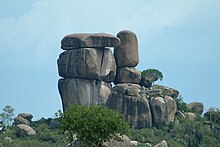Tor (rock formation)

A tor in Altai Krai, southern Siberia.
A tor, which is also known by geomorphologists as either a castle koppie or kopje, is a large, free-standing rock outcrop that rises abruptly from the surrounding smooth and gentle slopes of a rounded hill summit or ridge crest. In the South West of England, the term is commonly also used for the hills themselves – particularly the high points of Dartmoor in Devon and Bodmin Moor in Cornwall.[1]
Contents
1 Name
2 Formation
3 See also
4 References
5 Further reading
Name
The word tor (Cornish: tor, Old Welsh: twrr, Welsh: twr, Scottish Gaelic: tòrr), meaning hill,[2] is notable for being one of the very few Celtic loanwords to be borrowed into vernacular English before the modern era – such borrowings are mainly words of a geographic or topographical nature. Another such word is crag (from Welsh craig "rock").[citation needed]
Formation
Tors are landforms created by the erosion and weathering of rock; most commonly granites, but also schists, dacites, dolerites, coarse sandstones and others. Tors are mostly less than 5 meters (16 ft) high. Many hypotheses have been proposed to explain their origin and this remains a topic of discussion among geologists and geomorphologists, and physical geographers. It is considered likely that tors were created by geomorphic processes that differed widely in type and duration according to regional and local differences in climate and rock types.[1][3]

Kit-Mikayi, a celebrated tor near Kisumu, Kenya.
For example, the Dartmoor granite was emplaced around 280 million years ago, with the cover rocks eroded away soon afterwards, exposing it to chemical and physical weathering processes.[4] Where joints are closely spaced, the large crystals in the granite readily disintegrate to form a sandy regolith known locally as growan. This is readily stripped off by solifluction or surface wash when not protected by vegetation, notably during prolonged cold phases during the Quaternary ice ages - periglaciation.
Where joints happen to be unusually widely spaced, core blocks can survive and escape above the weathering surface, developing into tors. These can be monolithic, as at Haytor and Blackingstone Rock, but are more usually subdivided into stacks, often arranged in avenues. Each stack can comprise several tiers or pillows, which may become separated: rocking pillows are called logan stones. These stacks are vulnerable to frost action and often collapse leaving trails of blocks down the slopes called clitter or clatter. Weathering has also given rise to circular "rock basins" formed by the accumulation of water and repeated freezing and thawing. An example is found at Kes Tor on Dartmoor.
Dating of 28 tors on Dartmoor showed that most are surprisingly young, less than 100,000 years old, with none over 200,000 years old.[5] They probably emerged at the start of the last major ice age (Devensian). By contrast, in the Scottish Cairngorms which is the other classic granite tor concentration in Britain, the oldest tors dated are between 200 and 675,000 years old, with even glacially-modified ones having dates of 100-150,000 years.[6] This may reflect a dryer, more arctic climate.[citation needed]
See also
Bornhardt – A dome-shaped, steep-sided, bald rock outcropping
Etchplain – A plain where the bedrock has been subject to considerable subsurface weathering
Inselberg – Isolated rock hill or small mountain that rises abruptly from a relatively flat surrounding plain
Nubbin (landform) – A small and gentle hill consisting a bedrock core dotted with rounded residual blocks.- List of geographical tors
References
| Wikimedia Commons has media related to Tors. |
^ ab Ehlen, J. (2004) Tor in Goudie, A., ed., pp. 1054-1056. Encyclopedia of Geomorphology. Routledge. London, England.
^ Crossing's Guide to Dartmoor, 1912 Edition, 1965 Reprint (David & Charles, Newton Abbot)
^ Twidale, C.R., and J.R.V. Romani (2005) Landforms and Geology of Granite Terrains. A.A. Balkema Publishers Leiden, The Netherlands. 359 pp. .mw-parser-output cite.citation{font-style:inherit}.mw-parser-output .citation q{quotes:"""""""'""'"}.mw-parser-output .citation .cs1-lock-free a{background:url("//upload.wikimedia.org/wikipedia/commons/thumb/6/65/Lock-green.svg/9px-Lock-green.svg.png")no-repeat;background-position:right .1em center}.mw-parser-output .citation .cs1-lock-limited a,.mw-parser-output .citation .cs1-lock-registration a{background:url("//upload.wikimedia.org/wikipedia/commons/thumb/d/d6/Lock-gray-alt-2.svg/9px-Lock-gray-alt-2.svg.png")no-repeat;background-position:right .1em center}.mw-parser-output .citation .cs1-lock-subscription a{background:url("//upload.wikimedia.org/wikipedia/commons/thumb/a/aa/Lock-red-alt-2.svg/9px-Lock-red-alt-2.svg.png")no-repeat;background-position:right .1em center}.mw-parser-output .cs1-subscription,.mw-parser-output .cs1-registration{color:#555}.mw-parser-output .cs1-subscription span,.mw-parser-output .cs1-registration span{border-bottom:1px dotted;cursor:help}.mw-parser-output .cs1-ws-icon a{background:url("//upload.wikimedia.org/wikipedia/commons/thumb/4/4c/Wikisource-logo.svg/12px-Wikisource-logo.svg.png")no-repeat;background-position:right .1em center}.mw-parser-output code.cs1-code{color:inherit;background:inherit;border:inherit;padding:inherit}.mw-parser-output .cs1-hidden-error{display:none;font-size:100%}.mw-parser-output .cs1-visible-error{font-size:100%}.mw-parser-output .cs1-maint{display:none;color:#33aa33;margin-left:0.3em}.mw-parser-output .cs1-subscription,.mw-parser-output .cs1-registration,.mw-parser-output .cs1-format{font-size:95%}.mw-parser-output .cs1-kern-left,.mw-parser-output .cs1-kern-wl-left{padding-left:0.2em}.mw-parser-output .cs1-kern-right,.mw-parser-output .cs1-kern-wl-right{padding-right:0.2em}
ISBN 978-0415364355
^ "Dartmoor Factsheet: Tor Formation" (PDF). Dartmoor National Park. 2002. Archived from the original (PDF) on 30 September 2011. Retrieved 21 December 2011.
^ Gunnell, Y., Jarman, D. and 8 others, 2013. "The granite tors of Dartmoor, Southwest England: rapid and recent emergence revealed by Late Pleistocene cosmogenic apparent exposure ages." Quaternary Science Reviews 612, 62-76
^ Adrian Hall, "New perspectives on a classic landscape of selective linear glacial erosion", The history of the Cairngorms: granite, landscape and processes, British Geological Survey
Further reading
Mercer, Ian (2009). "The Physical Anatomy of Dartmoor". Dartmoor – A Statement of its Time. London: Collins. pp. 30–78. ISBN 978-0-00-718499-6.